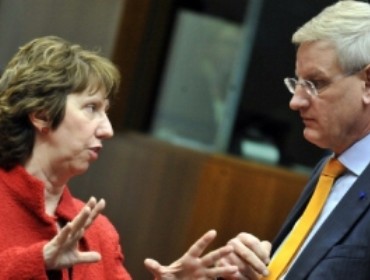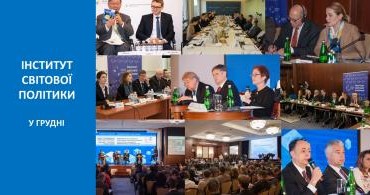Comment by Martin Lukac, intern of the Institute of World Policy, student of Comenius University (Bratislava, Slovakia)Negotiations about Deep and Comprehensive Free Trade Area, between Ukraine and the European Union have been going on since 2008. Both sides share suspicions about the other: the European Union questions Ukraine´s true commitment to the European integration while Ukraine is critical about the EU´s lack of flexibility. Worries of the European member states arose about the Ukrainian democratic standards and its will to implement European requirements. On the other hand, authorities in Kiev also do not blindly agree to everything coming from the west and refused to accept all conditions related to the implementation of DCFTA.
Ukraine may have its issues, but is the European Union´s approach to its Eastern neighbourhood really as sincere and altruistic as presented? According to the book that inspired me to write this article, it is just an effort of the EU for its own safety. The book is called “The Evolution of the European Union’s Neighborhood Strategies: The Case of the Eastern Partnership” and was written by Natia Ejoshvili, a policy analyst of the Ministry of Foreign Affairs of Georgia.
The European Union´s strategy to stabilize its vicinity by enlargement has been employed since its formation. The first case was Greece and shortly after that Spain and Portugal. For quite a long time the EU applied a policy of enlargement to make sure that its precious core is safe. What came hand in hand was probably so obvious that no one even noticed. Enlarging the European Union brought new neighbours with it, and also new threats to deal with. The latest enlargements in 2004 and 2007 are considered a turning point. Although they can be regarded quite successful, Europe itself needs time to settle up with challenges that arose thereof. As a result, the European Union engaged a strategy of stabilization – integration without membership, officially called the European Neighbourhood Policy.
As stated in the book, the integration is grasped as a repeatable process. We have witnessed success stories in the course of integration of the Central and Eastern European countries. Therefore, the EU is trying to repeat the process using conditionality. It supports correct behaviour and punishes the opposite. With reference to Emanuel Adler and Michael Barnett, specialists in the fields of International relations and security communities, it seems that the EU is trying to form a loosely coupled security community around its tightly coupled within. Ejoshvili states that the most important norm in this community is that war is unimaginable. This is a very important consequence of the Second World War. Practically, this idea does not exclude the fact that member states are led by their own interests, compete each other and finally does not exclude conflict either. The point remains that even if a conflict emerges, it would not be solved militarily.
The European Neighbourhood Policy (ENP) is a tool the European Union employs to secure its boarders, because further enlargement is unmanageable. It is very wide framework initiative that binds distinctive countries with diverse problems and interests and thus brings very little added value. As stated in the book, the Eastern Partnership (EaP) initiative should be more or less innovative, because it does not overlap with any of the former neighbour initiatives. The European Union refers to the EaP as to a tailor-made policy, because of its bilateral approach toward partner states. This approach should be based on Association Agreements concluded with each partner state separately, although there are negotiations only with Ukraine and Moldova so far. Howsoever, there is an opposite view of some neighbours themselves.
Despite regularly praised in joint statements and extolled, the bilateral approach of the EaP suits the European Union more than partner states. Each country can approach the integration with its own pace and agree how deeply it wishes to integrate. How noble. On the other hand, bilateral approach suits the European Union, because it turns aside a threat that the cooperating states will create common regional agenda against European. This might be able to influence European agenda, or even cause that these states would be able to act at the same level in the negotiations. Needless to say, unsuitable scenario for the EU.
The latest joint communication from May 2011 – A new response to a changing Neighbourhood indicates that the incentives of the cooperation with the European Union are mainly the Deep and Comprehensive Free Trade Area (DCFTA), visa liberalisation, financial aid and ultimately some minor regional initiatives. In return the EU demands Eastern Partners to meet the democratic standards and to implement reforms. The exchange seems fair, but how effective are the offered incentives?
To evaluate the situation very shortly, the DCFTA requires huge efforts from the Eastern Partners, whereas its achievement is conditional on the adoption of the EU trade legislation. Furthermore, as Ejoshvili states, the mercantilist approach of the member states, intensified by the financial crisis, makes the blockade of the states very probable.
Secondly, mobility is another lure. However, since now the facilitation has been applied only to a limited category of citizens and therefore quite restricted. Former promises of visa free travel for all cooperating countries from the Prague Declaration changed into proposal for visa liberalisation. Nonetheless, even the facilitation was reached only by an agreement that the partner countries will accept illegal migrants back to their country in turn. Apart from this, implementation of the Schengen agreement had opposite effect on the mobility. Reinforcement of the outer boarders of the European Union made it even harder to obtain visa and made it even more inaccessible.
Finally, the financial aid offered seems quite tempting. The fact is that the financial mechanism used, the ENPI, lacks enough financial resources and the aid itself is not very sufficient. Moreover, several scholars claim, and it is really worth a think, that no money will buy certain regimes. It is easy to demonstrate its insufficiency on the Transnistrian region, a Moldovan separatist region currently occupied by Russian Forces. According to the study of the Institute of World Policy, the European Union spent 500mil € during the 1991 – 2010 period and plans to allocate the same amount in the ongoing period 2010 – 2013. Moreover, up to 2013 the EU plans to spend more than 45mil € on the “Europeanization” of the citizens. In comparison to the Russian Federation that managed to spend $2bn on Transnistria in the form of subsidies for fuel, bonuses to pensions and wages throughout 1991 – 2010 it seems that the EU´s financial aid significantly lingers behind.
The problem that certainly dwells behind European financial aid is bureaucracy. In connection with wide-spread corruption in all EaP countries, it makes the help of the EU rather ineffective and, let´s say, clumsy. It is important to what extent can the EU influence happening in EaP countries in comparison with the Russian Federation. The fact is that the Russian Federation has a very straightforward impact on the EaP countries. Namely the gas dependence of Ukraine and Moldova, military presence in the states of Southern Caucasus as well as in mentioned Transnistrian region, and ultimately financial and political dependence of Belarus. Straight impact of Russian decisions on economic order or political viability of EaP countries makes it, in my perception, a quasi vetoist of their actions. In comparison to the EU that supports its partners via grants and complicated projects, making the procedures never-ending, the impact of the Russian impact is literally immediate. A deviation and there is immediately coming response in form of higher prices of gas, or even shutting the gas tap.
What is the Russian advantage in this? It is undoubtedly its willingness to support undemocratic regimes, mainly Southern Caucasus and Belarus, to offer cheap goods and a potential sales area, besides cheap gas. Which countries are virtually able to be integrated? I will simply exclude Belarus due to obvious reasons. Southern Caucasus is under Russian military presence and practically impossible to be grasped by the European Union. The result is Ukraine and Moldova. However, also here it can be noticed that these countries shuttle from one side to another – for example Ukrainian non-block status announced recently is a short term avoidance of clear declaration of its future heading, although in respect to mentioned circumstances, it is quite justifiable.
The situation is certainly very complicated from both points of view. The Eastern Partners, especially Ukraine and Moldova, are in an unenviable position because they are right between the two giants. Currently, it is important for the partners to keep consistent but not hastened pace by the Euro-integration so Russia does not get a pretext for any actions. On the other hand, the European Union should be ready to make compromises in all fields of integration to lighten the burden of the partners as much as it goes. In any case, the most important thing I see in the whole integration process is the spread of the democratic institutions. The rest is, more or less, just a surplus.
Publication

The Eastern Partnership: is it so innovative and efficient?
02:56 PM 27-7-2011



Comments theme
Comments themeComments themeComments themeComments themeComments themeComments themeComments themeComments themeComments themeComments themeComments themeComments themeComments themeComments themeComments themeComments themeComments themeComments themeComments themeComments.